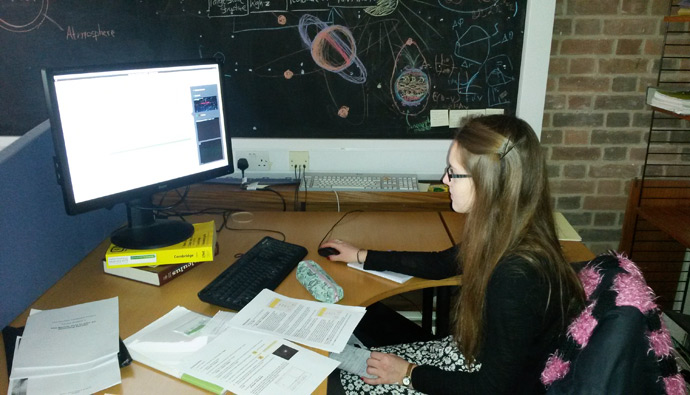
Student doing work experience at the Institute of Astronomy (IoA) in Cambridge. She is robotically controlling the Faulkes Telescope to be the first to confirm a supernovae discovered by Gaia. Image credit: Heather Campbell.
Today we are very happy to announce the new public web pages for Gaia Science Alerts hosted at our website. Gaia is monitoring the whole sky on average 100 times in a 5 year mission. Gaia was launched in December 2013, and started science operations in August 2014. Now that we have mapped the whole sky a few times we are ready to look for the rare things that change dramatically in the sky.
On our website will report new transients discovered by Gaia and offer you the chance to participate alongside professional and amateur astronomers in understanding what they are. Gaia finds new transients every day, and it is vital to try and identify what they are as quickly as possible. Many of them will be new Supernovae and Cataclysmic Variables. Some of them could be extremely rare and exotic events such as Tidal Disruption Events, or massive outbursts from young stars (FU Orionis stars). With your help we will try to identify them all (or at least a good fraction of them)!
If you are a member of a school, then there is an exciting option for your class to get involved in scheduling observations and making measurements with robotic telescopes spread throughout the world. Visit our Discover section to find out more about the telescopes and how to get involved.
If you have access to your own telescope (or have access through a club), we provide details on how to find some of the Gaia Alerts that you may be able to observe. In the future, we plan to provide a service where you can send images you take back to us, and we will provide you with a measurement of how bright an Alert is (and we may also ask you if we can use your data in a scientific publication).
If you are a teacher and want classroom resources, or if you are interested in learning more about Gaia Alerts and astronomy, then there is a range of educational materials offered in collaboration with the Faulkes Telescope Project.
You can dive straight in and start learning about how Gaia works, or look into the different kinds of transients that populate our own Milky Way and other galaxies.
You can see the list of transients we are currently trying to study, and those that we have already identified.
Exciting new discoveries and news articles can be found on our News pages. To learn more about the team of people behind the ESA Gaia mission, the team behind the alerts and the groups involved visit Who page.
Page last updated: 18 March 2016
